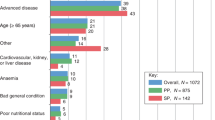Abstract
Purpose
Primary prophylaxis with granulocyte colony-stimulating factor (G-CSF) is used in many institutions across the UK due to unacceptable febrile neutropenia (FN) rates with FEC-D (fluorouracil, epirubicin, cyclophosphamide–docetaxel). The resultant reduction in FN rate is thought to maintain dose intensity and improve patient experience. This retrospective study was performed to assess whether the addition of G-CSF primary prophylaxis into daily clinical practice has achieved these aims.
Methods
Collaborative audit performed in two UK cancer centres before and after the integration of G-CSF primary prophylaxis with FEC-D. The primary objective was FN rate.
Results
Data from 342 patients were analysed, 151 before routine use of primary G-CSF and 191 after. The FN rates were 30 and 11 %, respectively. Despite the 99 % adherence to primary G-CSF policy, there were more dose reductions (8 increased to 13 %) and dose delays (11 increased to 23 %) following the use of G-CSF primary prophylaxis. This appeared to be due to non-FN toxicities. Inpatient days decreased substantially from 93 to 16 and antibiotic courses from 28 to 13 (per hundred patients).
Conclusions
Near universal adherence to the G-CSF policy in FEC-D treatment has led to a reduction in FN rate and inpatient days but has not translated into improved dose intensity. This collaborative audit allows sufficient data to give insight into current practice and generate hypotheses for further investigation.

Similar content being viewed by others
References
Smith TJ, Khatcheressian J, Lyman GH, Ozer H, Armitage JO, Balducci L, Bennett CL, Cantor SB, Crawford J, Cross SJ, Demetri G, Desch CE, Pizzo PA, Schiffer CA, Schwartzberg L, Somerfield MR, Somlo G, Wade JC, Wade JL, Winn RJ, Wozniak AJ, Wolff AC (2006) (ASCO expert panel). 2006 Update of ASCO practice guideline recommendations for the use of white blood cell growth factors: guideline summary. J Clin Oncol 2:4196–201
Herbst C, Naumann F, Kruse E, Knauel I, Schulz H, Bohlius J, Engert A (2008) Prophylactic antibiotics and G-CSF for the prevention of infections and improvement of survival in cancer patients undergoing chemotherapy (protocol). Cochrane Database Syst Rev 4:CD007107
Schelenz S, Giles D, Abdallah S (2012) Epidemiology, management and economic impact of febrile neutropenia in oncology patients receiving routine care at a regional UK cancer centre. Annal of Oncology 23:1889–1893
National Confidential Enquiry into Patient Outcome and Death (NCEPOD). For better or worse? Key findings from the NCEPOD report on patients who died within 30 days of receiving systemic anti-cancer therapy. 2008. Available at http://www.ncepod.org.uk/2008sact.htm
Department of Health Improving Outcomes. Improving outcomes: a strategy for cancer. 2011. Available at https://www.gov.uk/government/uploads/system/uploads/attachment_data/file/135516/dh_123394.pdf.pdf
NHS Improvement–Cancer. Transforming inpatient care: spreading the winning principles and good practice. 2012. Available at http://www.improvement.nhs.uk/cancer/
Timmer-Bonte JN, de Boo TM, Smit HJ, Biesma B, Wilschut FA, Cheragwandi SA, Termeer A, Hensing CA, Akkermans J, Adang EM, Bootsma GP, Tjan-Heijnen VC (2005) Prevention of chemotherapy-induced febrile neutropenia by prophylactic antibiotics plus or minus granulocyte colony-stimulating factor in small cell lung cancer: a Dutch randomised phase III study. J Clin Oncol 23:7974–7984
Vogel CL, Wojtukeiwicz MZ, Carroll RR, Tjulandin SA, Barajas-Figueroal J, Weins BL, Neumann TA, Schwartzberg LS (2005) First and subsequent cycle use of pegfilgrastim prevents febrile neutropenia in patients with breast cancer; a multicenter, double-blind, placebo-controlled phase III study. J Clin Oncol 23(6):1178–1184
Crawford J, Caserta C, Roila F, ESMO Guidelines Working Group (2010) Haematopoietic growth factors: ESMO clinical practice guidelines for the applications. Annal of Oncology 21(suppl 5):248–v251
National Institute for Health and Clinical Excellence. Neutropenic sepsis: prevention and management of neutropenic sepsis in cancer patients. CG151. London: National Institute for Health and Clinical Excellence. 2012. Available at http://guidance.nice.org.uk/CG151
Bonadonna G, Valagussa P, Moliterni A, Zambetti M, Brambilla C (1995) Adjuvant cyclophosphamide, methotrexate, and fluorouracil in node-positive breast cancer: the results of 20 years of follow-up. N Engl J Med 332:901–6
Roche H, Fumoleau P, Spielmann M, Canon JL, Delozier T, Serin D, Symann M, Kerbrat P, Soulie P, Eichler F, Viens P, Monnier A, Vindevoghel A, Campone M, Goudier MJ, Bonneterre J, Ferrero JM, Martin AL, Geneve J, Asselain B (2006) Sequential adjuvant epirubicin-based and docetaxel chemotherapy for node-positive breast cancer patients: The FNCLCC PACS 01 Trial. J Clin Oncol 24:5664–5671
Younis T, Rayson D, Thompson K (2012) Primary G-CSF prophylaxis for adjuvant TC or FEC-D chemotherapy outside of clinical trial settings: a systematic review and meta-analysis. Support Care Cancer 20:2523–2530
Hryniuk W, Bush H (1984) The importance of dose intensity in chemotherapy of metastatic breast cancer. J Clin Oncol 2:1281–1287
Krell D, Jones AL (2009) Impact of effective prevention and management of febrile neutropenia. British Journal of Cancer 101:23–26
Holmes J, Dunlop D, Hemmett L, Sharplin P, Bose U (2004) A cost-effectiveness analysis of docetaxel in the second-line treatment of non-small cell lung cancer. Pharmacoeconomics 22:581–589
Lyman GH, Lyman CH, Agboola O for the ANC study group (2005) Risk models for predicting chemotherapy-induced neutropenia. Oncologist 10:427–437
Acknowledgements
The authors would like to acknowledge the assistance with data collection of the following people, Breast Disease Group at The Christie Foundation Trust, Clatterbridge Cancer Centre Clinical Effectiveness team, Craig Marshall, Dr Ruth Conroy and Dr Stephen Kennedy.
Conflict of interest
Dr Mullard AP, Dr Sumra P, Dr Ali Z and Dr O’Reilly SM report no conflict of interest. Dr Misra V receives consultancy fees from Amgen and Teva UK. Dr Malik Z reports receiving honoraria for speaking at meetings, advisory boards or educational support to attend meetings from Amgen, Astra Zeneca, GSK, Janssen, Novartis, Pfizer, Roche and Sanofi.
Author information
Authors and Affiliations
Corresponding author
Rights and permissions
About this article
Cite this article
Mullard, A.P., Misra, V., Sumra, P. et al. Reducing febrile neutropenia rates in early breast cancer. Experience of two UK cancer centres. Support Care Cancer 22, 2033–2037 (2014). https://doi.org/10.1007/s00520-014-2141-3
Received:
Accepted:
Published:
Issue Date:
DOI: https://doi.org/10.1007/s00520-014-2141-3




